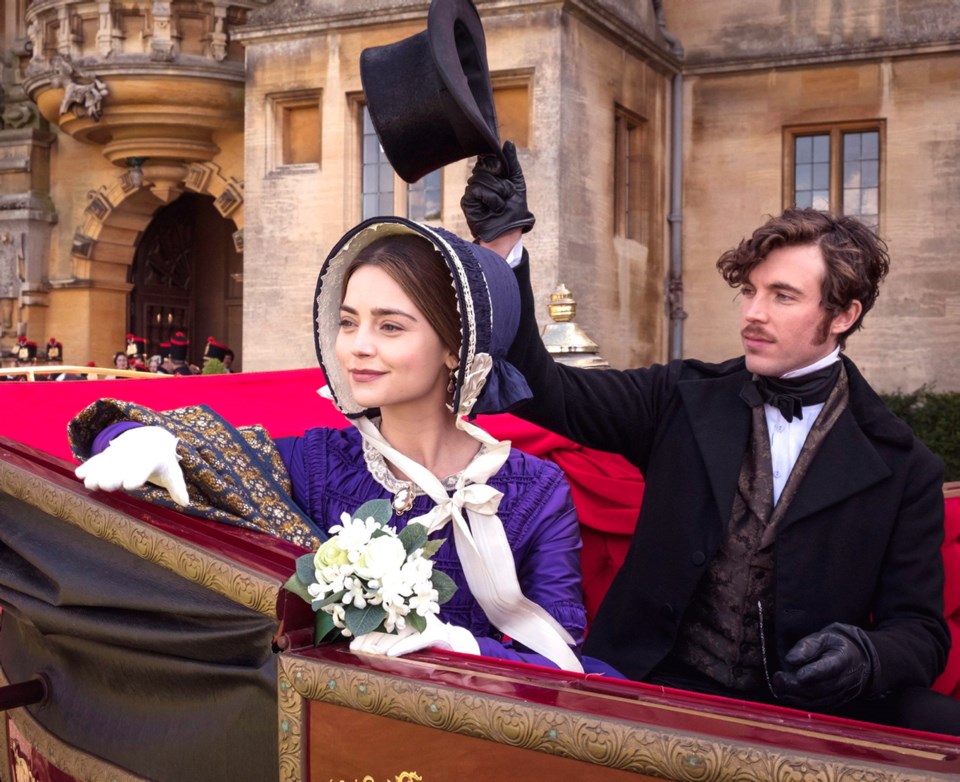BEVERLY HILLS, California — When female liberation came along, it assured women they could have it all. They could chair board meetings, set government policy, bear children and still have a pot roast on the stove. But they were 100 years too late.
Queen Victoria, who sat on the throne 63 years, had already done it. While she was expanding the reaches of the British Empire, she was increasing the local population by bearing nine children.
How she managed those demands is the theme of Masterpiece’s second season of Victoria, which premières tonight on PBS.
“It’s no fun being pregnant all the time, especially when you’re queen and you’ve got this very demanding job,” says Daisy Goodwin, who created and wrote the series.
Victoria assiduously kept a diary, and much of the source material for the show is culled from that, says Goodwin. “The moment you’re pregnant, as she says, and you swell up like a pumpkin, everyone goes: ‘Ugh, you’ve got hormones. You can’t rule the country anymore.’ So that’s what she hates. She hates that loss of status and control that happens while you’re pregnant and just afterwards,” says British-born Goodwin.
“She doesn’t want to go on the ‘mommy’ track ever. That’s the thing about Victoria. She wants to get back and get back to work.”
While she loved her children, Goodwin says Victoria was a woman in desperate need of contraception. “Her second baby was conceived pretty much a month after she’s given birth to Vicky, so she has two babies in under a year. And, for anybody, that’s hard. And she has post-natal depression after the second baby. So her relationship with her children was complicated. She loves them passionately, but she’s not gushy about them,” Goodwin says.
“There’s a line in one of her diaries where she says: ‘Newborn infants look like frogs to me.’ I mean, she’s a little scared of them. And you’ve got to remember, she’s only 21. You know, she’s 21 and she’s had two children. And in real life, she has five children in four years, so that’s a lot.”
British actor Jenna Coleman plays Queen Victoria. “I did lot of research on Victoria — how creative she was, which I never knew,” Coleman says.
“She had such passion for music and opera and ballet and visuals. She created her own wedding dress, and wrote in her diary, and did watercolour and sketch, and she tried to learn how to sing opera,” she says.
“She had people come around to the house and teach her. She’s so vibrant and full of life and unapologetically full of life, never tried to hide it or pull back from it, which I really love about her. She’s really inconsistent and very flawed, but I love that. I think that’s what’s been quite tricky to play her being unashamedly flawed. I’m trying to make that likable. It’s really tricky, but it’s who she was and it’s what makes her so marvellous.”
Tom Hughes, who plays the dashing Albert, Victoria’s adored husband, says he didn’t know much about Prince Albert when he took on the role. “What definitely drew me to this project initially, was these are two young people in very unique situations in life,” he says.
“And to see that impact upon them as animals almost, as human, was a fascinating thing as an actor to bring to life.”
Albert was not only romantic, he was resourceful, Hughes says. “You then have the added ingredient to the mixture with Albert that there’s just so much that he successfully turned his hand to, at least tried to turn his hand to, and there are incredible facets to his personality.
“And in my interpretation, there’s a very strident, inquisitive nature to him that really, I think, is well suited to the era.
“You know, this is right at the early onset of the Industrial Revolution. You think it’s only maybe five lifetimes, if that, away from the present day. And in many ways it’s a completely different world.
“But there is this new frontier that’s appearing on the horizon. And I think Albert’s natural inclination is to always look towards those things and embrace them, however eccentric and left-of-field they may appear.”
Goodwin agrees that Albert was a dandy handyman.
“Not only did he invent this wonderful device which meant that when they were in bed, he could lock the door without them getting out of bed, which, I think, shows [his versatility]. And the other thing he did, which, I think, makes him a real hero, is that he installed indoor plumbing in the palace,” Goodwin says.
“He installed water closets, lavatories in the palace. But he didn’t just do it upstairs. He was the first person to put a toilet in for the servants in Buckingham Palace. So I think that shows his good side, really.”



